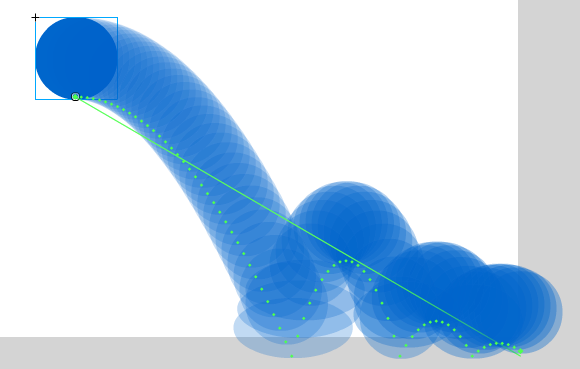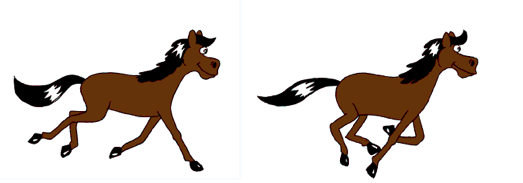Applying Animation Principles In Flash

Read instructions carefully. Some questions require more than one answer!
If you want to receive credit for the quiz, enter your complete first and last name.
You may want to take this in fullscreen mode to better see the images.
- 1.
When a character stops walking and his hair continues to move is an example of which animation principle? (choose one)
- A.
Overlapping Action
- B.
Follow-through
- C.
Drag
- D.
Secondary Action
- E.
Moving Hold
Correct Answer
B. Follow-throughExplanation
When a character stops walking and his hair continues to move, it is an example of the animation principle called "Follow-through." Follow-through refers to the continuation of movement in certain parts of an object or character after the main action has stopped. In this case, the character's hair continues to move due to its inertia, even though the character has stopped walking. This principle adds realism and fluidity to the animation.Rate this question:
-
- 2.
How would the animation principle slow in and slow out be applied in Flash? (choose all that apply)
- A.
On the properties panel
- B.
In the custom ease window
- C.
Applied directly to a frame span of a motion tween
- D.
Applied directly to a symbol
- E.
In the motion editor
Correct Answer(s)
A. On the properties panel
B. In the custom ease window
C. Applied directly to a frame span of a motion tween
E. In the motion editorExplanation
The animation principle slow in and slow out can be applied in Flash in multiple ways. On the properties panel, you can adjust the easing options to create a slow in and slow out effect. In the custom ease window, you can customize the easing curve to achieve the desired animation effect. Applied directly to a frame span of a motion tween, you can set different easing options for different frames to create a gradual acceleration or deceleration. In the motion editor, you can use the graph editor to adjust the easing of the animation.Rate this question:
-
- 3.
A completely flat line on the custom easing graph indicates: (choose one)
- A.
No movement
- B.
Fast, frontward movement
- C.
Slow, backward movement
- D.
Floating movement
- E.
Abrupt movement
Correct Answer
A. No movementExplanation
A completely flat line on the custom easing graph indicates no movement because there is no change in the position or velocity of the object over time. The flat line represents a constant value, indicating that the object remains stationary without any motion or change in its position.Rate this question:
-
- 4.
What characteristics in Flash does this graphic express? (choose four)
- A.
Motion Tweens
- B.
Onionskinning
- C.
Easing
- D.
Squash and Stretch
- E.
Secondary Action
Correct Answer(s)
A. Motion Tweens
B. Onionskinning
C. Easing
D. Squash and StretchExplanation
This graphic expresses the characteristics of Motion Tweens, Onionskinning, Easing, and Squash and Stretch. Motion Tweens refer to the smooth animation of an object or graphic from one point to another. Onionskinning is a technique that allows animators to see multiple frames at once, helping with the creation of smooth transitions. Easing refers to the gradual acceleration or deceleration of an animation, creating a more natural movement. Squash and Stretch is a principle that adds weight and flexibility to objects in motion, giving them a more dynamic and lively appearance. Secondary Action, however, is not expressed in this graphic.Rate this question:
-
- 5.
LasLook at the tail of this horse carefully. It is a example of which Animation Principle? (choose one)
- A.
Primary Action
- B.
Secondary Action
- C.
Overlapping Action
- D.
Squash and Stretch
- E.
Timing
Correct Answer
B. Secondary ActionExplanation
Secondary Action refers to the additional movements that enhance and support the primary action in an animation. In this case, the tail of the horse is not the main focus of the animation, but it adds to the overall movement and realism of the horse's motion. The tail's movement is secondary to the main action of the horse's body and legs. Therefore, the tail of the horse in the given image exemplifies the principle of Secondary Action.Rate this question:
-
- 6.
Straight ahead action: (choose all that apply)
- A.
Requires more keyfames in Flash
- B.
Requires more drawing in Flash
- C.
Requires less drawing in Flash
- D.
Requires less keyframes in Flash
- E.
Produces more realistic results
Correct Answer(s)
A. Requires more keyfames in Flash
B. Requires more drawing in Flash
E. Produces more realistic resultsExplanation
Straight ahead action refers to animating frame by frame without using any keyframes or interpolation. This technique requires more keyframes in Flash because each frame needs to be manually drawn or adjusted. It also requires more drawing in Flash because every frame needs to be created individually. Additionally, straight ahead action can produce more realistic results as it allows for more fluid and organic movements.Rate this question:
-
- 7.
An animation at 30 frame per second (fps) would need how many frames to play for 1 minute? (choose one)
- A.
180
- B.
3600
- C.
900
- D.
1800
Correct Answer
D. 1800Explanation
An animation at 30 frames per second (fps) means that 30 frames are displayed every second. To calculate the number of frames needed to play for 1 minute, we multiply the number of seconds in a minute (60) by the frames per second (30). Therefore, the correct answer is 60 x 30 = 1800 frames.Rate this question:
-
- 8.
Arcs describe the natural way a human walks. Which of the following statements are true? (choose all that apply)
- A.
There is a tool in Flash that applies arcs.
- B.
Arcs are considered an animation principle.
- C.
Arcs follow a S-shaped curve.
- D.
Arcs can be achieved through squash and stretch techniques.
Correct Answer(s)
B. Arcs are considered an animation principle.
C. Arcs follow a S-shaped curve.
D. Arcs can be achieved through squash and stretch techniques.Explanation
Arcs are considered an animation principle because they are a fundamental concept in animation that helps to create more natural and realistic movement. Arcs follow a S-shaped curve because when a human walks, their limbs move in a curved path rather than a straight line. Arcs can be achieved through squash and stretch techniques because these techniques involve manipulating the shape and volume of an object to create the illusion of movement along a curved path.Rate this question:
-
- 9.
Pose to pose animation is accomplished in Flash by using: (choose one)
- A.
Motion Tweening
- B.
Frame-by-Frame only
- C.
Nesting graphics
- D.
Swapping symbols
- E.
Duplicating symbols
Correct Answer
A. Motion TweeningExplanation
Motion Tweening is the correct answer because it is a technique used in Flash to create smooth animations by defining the starting and ending positions of an object and allowing Flash to automatically generate the in-between frames. This saves time and effort compared to creating each frame individually in frame-by-frame animation. Nesting graphics, swapping symbols, and duplicating symbols are also techniques used in Flash, but they are not specific to pose to pose animation.Rate this question:
-
- 10.
Anticipation is used to prepare the audience for an action. Which of the following are examples of anticipation? (choose more than one answer)
- A.
A dancer bending her knee before jumping in the air.
- B.
A boy raising his arm and bringing it backwards before throwing a ball.
- C.
The scarf moving on a character after the character sits downs.
- D.
A hound's loose jowls move in the opposite direction of his stride.
- E.
A girl blowing a kiss brings her hand to her mouth.
Correct Answer(s)
A. A dancer bending her knee before jumping in the air.
B. A boy raising his arm and bringing it backwards before throwing a ball.
E. A girl blowing a kiss brings her hand to her mouth.Explanation
Anticipation is the act of preparing the audience for an action. In the examples given, the dancer bending her knee before jumping in the air, the boy raising his arm and bringing it backwards before throwing a ball, and the girl bringing her hand to her mouth before blowing a kiss all demonstrate anticipation. These actions signal to the audience that something is about to happen, building suspense and creating a sense of expectation. The movement of the scarf on a character after the character sits down and the movement of a hound's loose jowls in the opposite direction of his stride do not involve anticipation as they do not prepare the audience for an action.Rate this question:
-
Quiz Review Timeline +
Our quizzes are rigorously reviewed, monitored and continuously updated by our expert board to maintain accuracy, relevance, and timeliness.
-
Current Version
-
Mar 21, 2023Quiz Edited by
ProProfs Editorial Team -
Sep 30, 2008Quiz Created by
Emb03
 Back to top
Back to top



